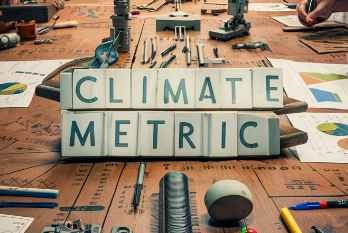Climate Metrics: Tools and Techniques delves into the fundamental methodologies and instruments used to measure and analyze important weather indicators critical to agricultural production. This article covers temperature and humidity sensor housing, relative humidity computation with dry and wet bulb thermometers, and statistical analysis of meteorological data like averages, standard deviations, and total rainfall. Understanding these tools and strategies allows farmers and agricultural professionals to optimize crop management and increase yield through precise climate monitoring.
Table of Contents
Introduction to Climate Metrics

Climate metrics are critical tools that help scientists and policymakers understand and handle the complexities of climate change. These metrics include a wide range of data points that reflect changes in the Earth’s climate, such as temperature, precipitation, sea level rise, and greenhouse gas levels. Climate metrics are most important because they may provide a quantitative framework for evaluating the effectiveness of mitigation and adaptation initiatives. By carefully tracking and analyzing these variables, stakeholders may make educated decisions to mitigate the negative effects of climate change.
Climate metrics have existed since the beginning of weather observation. Initially, climatic data were collected using simple methods such as manual temperature readings and basic precipitation measures. The equipment and procedures for assessing climatic variables evolved in tandem with scientific knowledge and technological advancement. The advent of satellite technology in the mid-twentieth century was a big step forward, enabling for more precise and extensive data collection at the global level. Today, sophisticated sensors and computer models are used to study climate metrics with remarkable accuracy.
To measure temperature and humidity for agricultural purposes, it’s essential to have the right housing and equipment. Here’s a comprehensive guide:
Housing for Temperature and Humidity Measurement
1. Stevenson Screen:
- Purpose: Protects instruments from moisture and direct sunlight while allowing airflow.
- Construction: Made of wood, painted white with louvered sides.
- Placement: In an open location, it is installed 1.2-2 meters above ground.
2. Automatic Weather Station (AWS):
- Components: Sensors for temperature, humidity, precipitation, wind speed, and direction.
- Data Logging: Data loggers are installed to ensure continual monitoring.
- Placement: Often located in fields and fueled by solar energy.
Units for Measurement
- Temperature: Degrees Celsius (°C) or Fahrenheit
- Humidity: Percentage (%)
- Rainfall: Millimetres (mm) or inches (in)
Crop-Specific Temperature and Humidity Requirements
Different crops have specific temperature and humidity requirements. Here are some examples:
- Wheat
- Temperature: 15-25 °C
- Humidity: 40-70%.
- Rice
- Temperature: 20–30°C
- Humidity: 70–90%
- Corn
- Temperature: 18–27°C
- Humidity: 50-60%.
- Tomatoes
- Temperature: 18–24°C
- Humidity: 60–80%
Tools and Techniques for Measuring Climate Metrics
In the field of climate science, accurate and trustworthy data collection is essential. Various instruments and techniques are used to measure climate measurements, each with its own set of methodologies, benefits, and limits. Satellites, weather stations, ocean buoys, and remote sensing technologies are among the most widely used instruments.
Satellites play an important role in climate monitoring since they provide comprehensive, worldwide data. They measure a variety of parameters, including temperature, humidity, and air composition. This data is acquired using sensors that detect various wavelengths of radiation. The fundamental advantage of satellites is their capacity to cover large areas while providing consistent, long-term datasets. However, they may be limited by temporal resolution and the necessity for calibration with ground-based data.
Weather stations, on the other hand, provide high-frequency, localized information. These stations monitor temperature, precipitation, wind speed, and other meteorological factors. They are strategically positioned to provide a thorough insight of specific regions. While very accurate, weather stations have limited geographical coverage and may not reflect broader climate trends.
Ocean buoys are crucial for measuring sea surface temperatures, salinity, and currents. These floating gadgets are equipped with sensors that collect data at varying depths. Ocean buoys assist scientists study marine processes and their impact on global climate. However, their deployment is resource-intensive, and they are susceptible to harsh marine environments.
Remote sensing technologies, such as radar and lidar, provide an additional layer of data acquisition. These instruments measure characteristics such as surface elevation, vegetation, and cloud cover. Remote sensing delivers detailed spatial information by generating signals and evaluating their reflections. The primary limitation is the intricacy of data interpretation, which necessitates advanced algorithms and knowledge.
Advanced technologies, such as machine learning and big data analytics, have transformed climate metric measurement. Machine learning algorithms can find patterns and trends in large datasets, which improves predicted accuracy. Big data analytics enables the processing of huge volumes of data, allowing for real-time analysis and decision-making. For example, using machine learning into satellite data analysis has increased the precision of climate models, resulting in more accurate projections.
Frequently Asked Question(FAQ)
What is the purpose of measuring climate metrics like temperature and humidity in agriculture?
Climate measurements assist farmers and agricultural scientists analyze and manage the climatic factors that influence crop development. This knowledge helps to optimize irrigation, control illnesses, and increase yield quality and quantity.
What tools are commonly used to measure temperature and humidity?
The commonly used tools to measure temperature and humidity are: Thermometers, Hygrometers, Stevenson Screens, Automatic Weather Stations (AWS).
Related Articles

